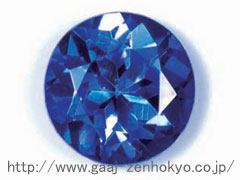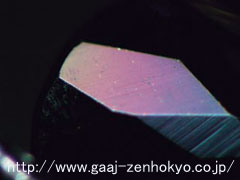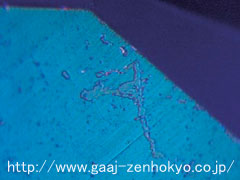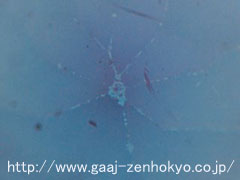|
??Blue to violet variety of zoisite is often called tanzanite, which leaped to fame due to a promotion by Tiffany & Co. in the 1980s.
??Some of pale blue zoisite were treated by coating in order to produce deeper colour. An advanced report on this treatment was released on the website of AGTA-GTC and AGL (American Gemological Laboratories) on 23 May 2008. The report specifies that they had obtained several samples of coated zoisite from Evan Caplan of Omi Gems, Inc. and the coating was detected by magnification tests and EDXRF analysis. GIA also reported on the material on 6 June (GIA Insider, Vol.10, No.10 June 6). GIA has been continuously studying the coating treatment on many gem varieties, and the report said that such coated zoisite was first seen around April 2008. The samples analysed were two pieces of emerald cut over 3 carats and 18 pieces of round cut in 4 to 5 mm size, and the result of the analysis coincided with the report of AGTA-GTC and AGL mentioned above.
??As Zoisite was one of the popular gemstones in the U.S., reports were instantly printed on sites such as gem news and blogs that draw attention in the industry.
??In Japan as well, an example of analysis performed on the material by a Japanese gem laboratory was reported on the JKS News issued on 21 August and also on its website.
??Around the same time the details of the analysis were reported on Gems & Gemology Summer 2008, issued by GIA under the title “Coated Tanzanite" (McClure and Shen. 2008).
??The coating process used for zoisite has not been released so far; on the other hand, other gemstones have been traditionally coated. For example, diamond is often coated by siliceous substance or calcium fluoride containing Au or Ag as an additive, and topaz coated by Fe, Ti or Co, and the coated layer is reportedly formed by vacuum evaporation in thickness under 100 nanometre (Shen et, al., 2007, Hayashi. 1997. Gemmology. Vol.32, 2001, Schmetzer. 2006).
??GAAJ-ZENHOKYO Laboratory obtained a coated zoisite and analysed it (figure 1). Coating treatment has been preformed on various gemstones including diamond and its detection technique can be applied to this new material.
 |
|
|
??Firstly, magnification test shows three features:
 Rainbow-colour iridescence observed from facets on pavilion (figure 2). This is caused by gap between the coating layers. Unnatural iridescence in the reflected light should raise caution whether treated. Rainbow-colour iridescence observed from facets on pavilion (figure 2). This is caused by gap between the coating layers. Unnatural iridescence in the reflected light should raise caution whether treated.
 Exfoliation of coating layer along facet edges or around a culet (figure 3). This can be confirmed by microscope magnification test with reflected light on the surface, but differential interference microscope will give you detailed observation with higher magnification especially on smaller stones that are difficult to observe with a standard gemmological microscope. Exfoliation of coating layer along facet edges or around a culet (figure 3). This can be confirmed by microscope magnification test with reflected light on the surface, but differential interference microscope will give you detailed observation with higher magnification especially on smaller stones that are difficult to observe with a standard gemmological microscope.
 Observation of the stone on a white sheet of diffuser (or a thin white paper) with illuminating the sheet by a strong light from beneath (figure 4). The coating layer has been abraded away, which appears in lighter colour. This can be more clearly observed by immersing the stone in methylene iodide. This test is operated easily with no special instrument, thus it must be the most effective for inspection. Observation of the stone on a white sheet of diffuser (or a thin white paper) with illuminating the sheet by a strong light from beneath (figure 4). The coating layer has been abraded away, which appears in lighter colour. This can be more clearly observed by immersing the stone in methylene iodide. This test is operated easily with no special instrument, thus it must be the most effective for inspection.
 |
 |
 |
|
fig-2:
|
Rainbow-coloured iridescence by coating
|
|
|
fig-3:
|
Exfoliation of coating
|
|
|
fig-4:
|
Observation with a white diffuser
|
|
|



